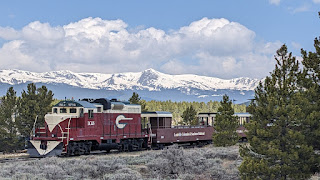View in browser
**Authentically Human! Not Written by AI**
 |
The Grand Opening.
How many people attended? I heard 850. |
This week marked the 10th anniversary of the Plein Air Convention & Expo – and also my 10th anniversary with the event, since I was present at its inception. That first year, in Las Vegas, we had snow. This year, in Denver, we had smoke, thunderstorms, hail and, I heard, also some snow. Interestingly, I spoke with another long-time participant who joked: “Bad weather seems to follow PACE like a bad penny.”
Normally, one would usually just shoot up to Denver from New Mexico via I-25. But we decided to make more of a vacation out of it, taking the scenic route via Pagosa Springs, Buena Vista and Leadville. It was like a trip back in time as spring seemed to reverse the higher up we went. In Pagosa Springs, the light spring greens were deepening into the shadowy hues of summer; but in Leadville, the aspens showed just the slightest hint of green. By the way, we saw plenty of snow at Wolf Creek Pass (10,856 feet), where we took a hike on snowpack that was about six feet deep.
Denver, of course, was already into summer, since it sits at a much lower elevation. Fortunately, we had a cool AirBnB, and it was just a few miles from the convention center. (We didn't stay at the hotel because our dog, Raku, insisted on a place with a full kitchen.) We arrived Sunday, and that afternoon PACE opened up officially with rousing music from a bluegrass band; followed by a gospel choir in full dress; then a juggler; and finally the Master of Ceremonies, Eric Rhoads, who is also publisher of PleinAir Magazine. You never know what Eric has planned for the opening event.
Monday, the convention got down to business. As always, it was a banquet of tasty offerings. PACE presented the participant with so many simultaneous events that you couldn't participate in them all. (“I want to keep you busy,” Eric said.) Besides the main stage, smaller stages for oil, watercolor and pastel provided more intimate settings. The good news is, if you couldn't attend every session, they were recorded for later consumption.
Afternoons were reserved for paintouts. Each one offered something different. On Monday, downtown Golden gave us historic buildings as well as views of Clear Creek; onTuesday, Eldorado Canyon State Park gave us stupendous cliffs towering over whitewater rapids; on Wednesday, Garden of the Gods (in Colorado City) gave us an alien landscape of giant boulders and weird rock formations; and finally, on Thursday, Rocky Mountain National Park gave us up-close-and-personal views of the Rockies' highest snowclad peaks.
Each day, I demonstrated at Judson’s Art Outfitters booth in the vendor room. This was a real pleasure, as I had many people coming to watch and to chat. And of course, I was happy to be there to support Judson's, which has so faithfully supported me over the years. Thank you, Carl and Sarah!
On the almost-last day of the event, the venue for 2024 was announced: Great Smoky Mountains National Park and the Biltmore Estate. The convention will be held in Cherokee, North Carolina.
Now that the convention is over, it's time to finish packing up my New Mexico studio. When you hear from me next, it will be from my summer studio on Campobello Island!
Here are some pictures, starting with some travel pictures:
 |
| Near Pagosa Springs, where I'm leading a painting retreat this fall |
 |
| Wolf Creek Pass |
 |
| Buena Vista vista |
 |
| The things you find in the forest |
 |
| Leadville |
 |
| The art show! Faculty and participants offered work for sale |
 |
| The plein air bear |
 |
| Doug Dawson pastel demonstration |
 |
| Bedazzled participants, just off the bus, looking for a painting spot in Golden |
 |
| A demo I made, using Judson's 8x10 Cigar Box Pochade |
 |
| Eldorado Canyon State Park |
 |
| Painting by the rapids |
 |
| Four of these mighty motorcoaches transported painters to the painting sites; at Eldorado Canyon, they kicked up a bit of dust |


































